牛津译林版(2019)选择性必修 第一册Unit 1 Food matters Extended reading 课件(39张ppt)
文档属性
| 名称 | 牛津译林版(2019)选择性必修 第一册Unit 1 Food matters Extended reading 课件(39张ppt) | 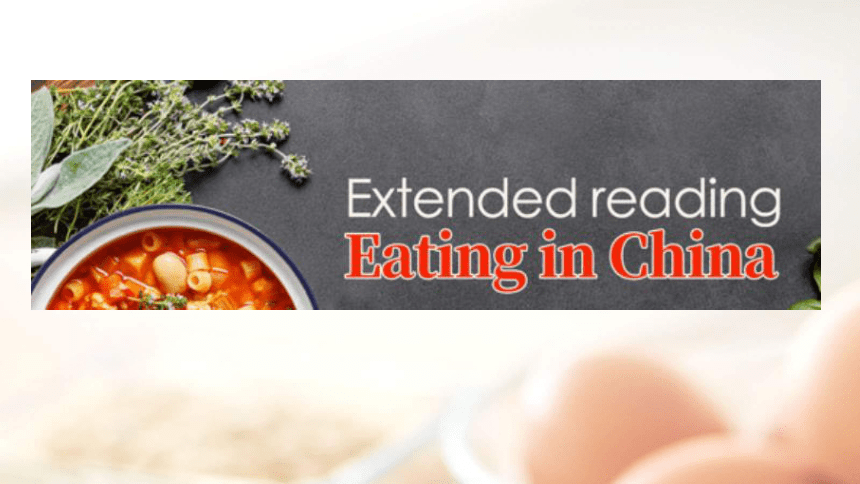 | |
| 格式 | zip | ||
| 文件大小 | 1.3MB | ||
| 资源类型 | 教案 | ||
| 版本资源 | 牛津译林版(2019) | ||
| 科目 | 英语 | ||
| 更新时间 | 2021-07-04 19:03:33 | ||
图片预览


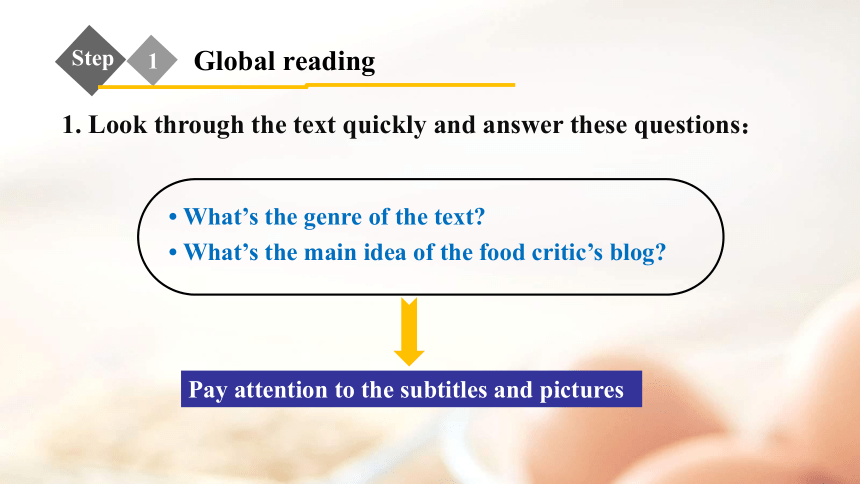
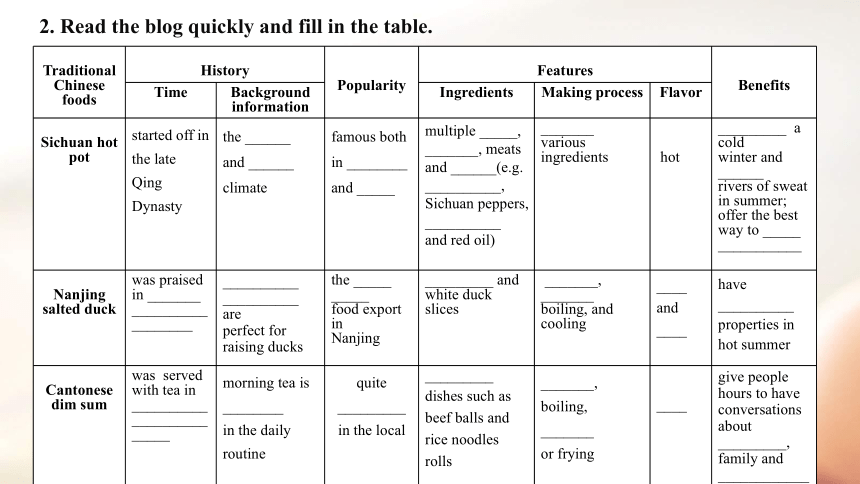
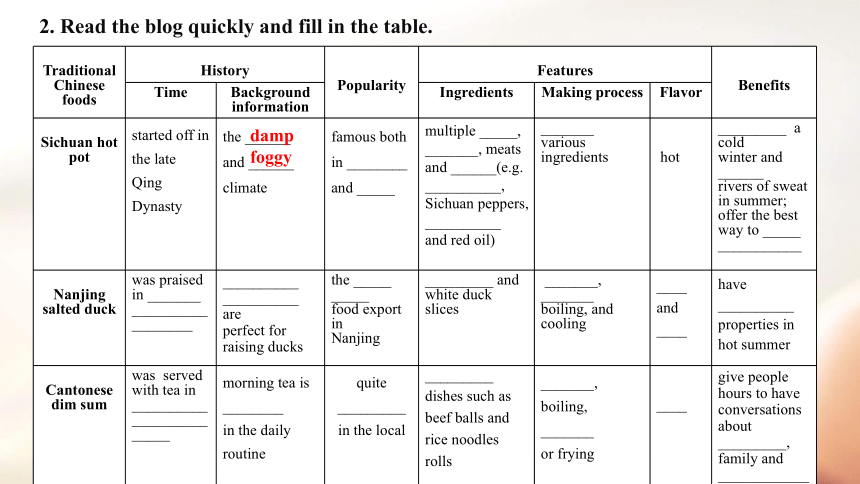
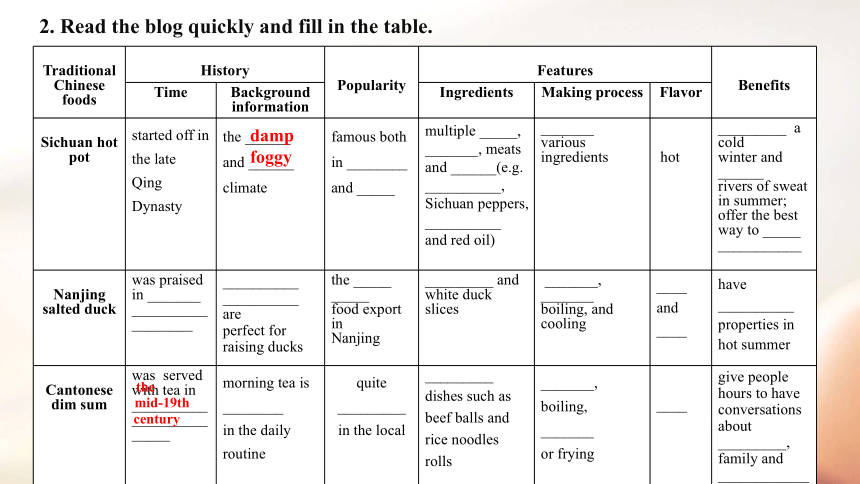


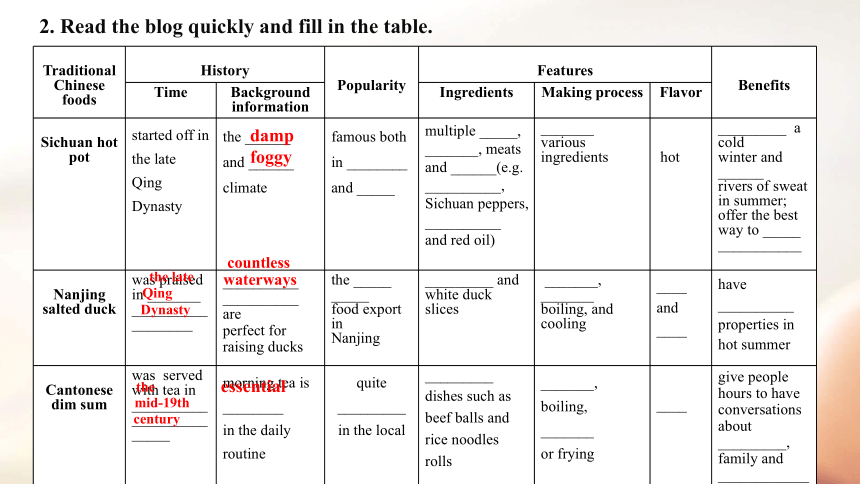
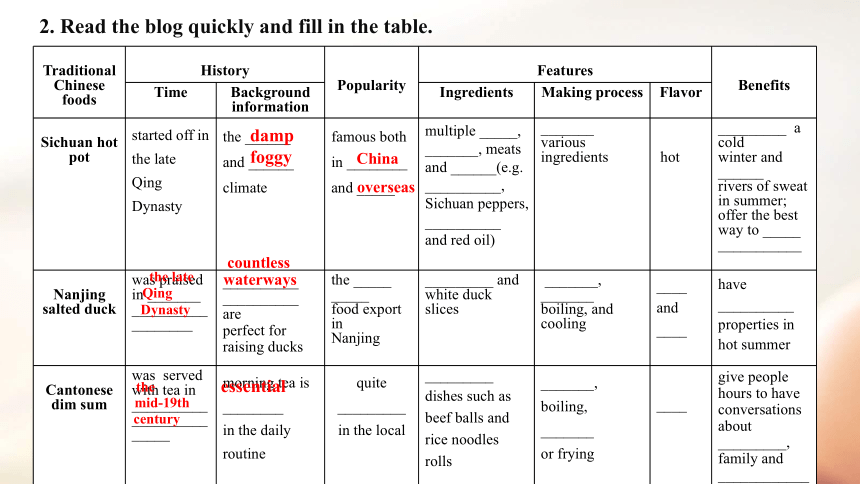
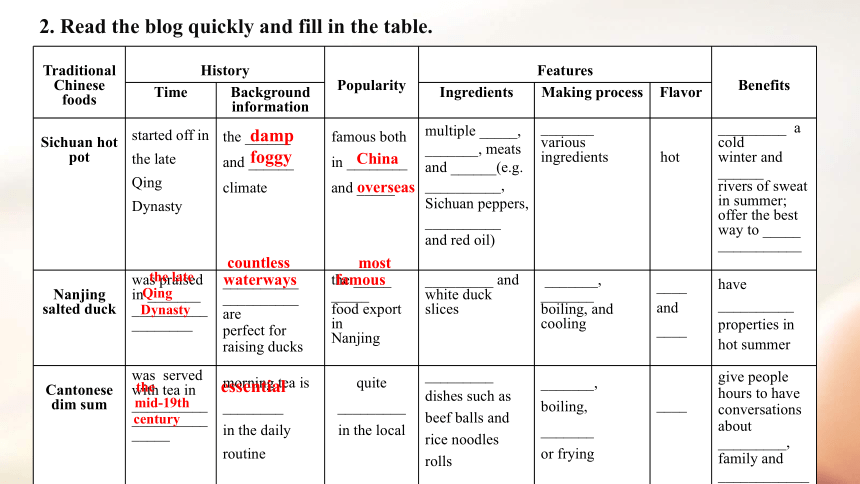
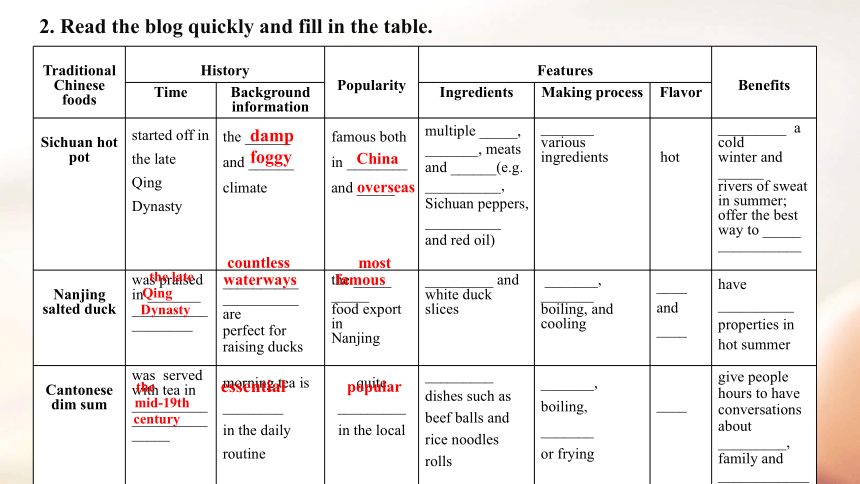
文档简介
(共39张PPT)
Step
1
Global
reading
1.
Look
through
the
text
quickly
and
answer
these
questions:
?
What’s
the
genre
of
the
text?
?
What’s
the
main
idea
of
the
food
critic’s
blog?
Step
1
Global
reading
1.
Look
through
the
text
quickly
and
answer
these
questions:
?
What’s
the
genre
of
the
text?
?
What’s
the
main
idea
of
the
food
critic’s
blog?
Pay
attention
to
the
subtitles
and
pictures
2.
Read
the
blog
quickly
and
fill
in
the
table.
Traditional
Chinese
foods
History
Popularity
Features
Benefits
Time
Background
information
Ingredients
Making
process
Flavor
Sichuan
hot
pot
started
off
in
the
late
Qing
Dynasty
the
______
and
______
climate
famous
both
in
________
and
_____
multiple
_____,
_______,
meats
and
______(e.g.
__________,
Sichuan
peppers,
__________
and
red
oil)
_______
various
ingredients
hot
_________
a
cold
winter
and
______
rivers
of
sweat
in
summer;
offer
the
best
way
to
_____
___________
Nanjing
salted
duck
was
praised
in
_______
__________________
__________
__________
are
perfect
for
raising
ducks
the
_____
_____
food
export
in
Nanjing
_________
and
white
duck
slices
_______,
_______
boiling,
and
cooling
____
and
____
have
__________
properties
in
hot
summer
Cantonese
dim
sum
was
served
with
tea
in
_________________________
morning
tea
is
________
in
the
daily
routine
quite
_________
in
the
local
_________
dishes
such
as
beef
balls
and
rice
noodles
rolls
_______,
boiling,
_______
or
frying
____
give
people
hours
to
have
conversations
about
_________,
family
and
____________
2.
Read
the
blog
quickly
and
fill
in
the
table.
Traditional
Chinese
foods
History
Popularity
Features
Benefits
Time
Background
information
Ingredients
Making
process
Flavor
Sichuan
hot
pot
started
off
in
the
late
Qing
Dynasty
the
______
and
______
climate
famous
both
in
________
and
_____
multiple
_____,
_______,
meats
and
______(e.g.
__________,
Sichuan
peppers,
__________
and
red
oil)
_______
various
ingredients
hot
_________
a
cold
winter
and
______
rivers
of
sweat
in
summer;
offer
the
best
way
to
_____
___________
Nanjing
salted
duck
was
praised
in
_______
__________________
__________
__________
are
perfect
for
raising
ducks
the
_____
_____
food
export
in
Nanjing
_________
and
white
duck
slices
_______,
_______
boiling,
and
cooling
____
and
____
have
__________
properties
in
hot
summer
Cantonese
dim
sum
was
served
with
tea
in
_________________________
morning
tea
is
________
in
the
daily
routine
quite
_________
in
the
local
_________
dishes
such
as
beef
balls
and
rice
noodles
rolls
_______,
boiling,
_______
or
frying
____
give
people
hours
to
have
conversations
about
_________,
family
and
____________
damp
foggy
2.
Read
the
blog
quickly
and
fill
in
the
table.
Traditional
Chinese
foods
History
Popularity
Features
Benefits
Time
Background
information
Ingredients
Making
process
Flavor
Sichuan
hot
pot
started
off
in
the
late
Qing
Dynasty
the
______
and
______
climate
famous
both
in
________
and
_____
multiple
_____,
_______,
meats
and
______(e.g.
__________,
Sichuan
peppers,
__________
and
red
oil)
_______
various
ingredients
hot
_________
a
cold
winter
and
______
rivers
of
sweat
in
summer;
offer
the
best
way
to
_____
___________
Nanjing
salted
duck
was
praised
in
_______
__________________
__________
__________
are
perfect
for
raising
ducks
the
_____
_____
food
export
in
Nanjing
_________
and
white
duck
slices
_______,
_______
boiling,
and
cooling
____
and
____
have
__________
properties
in
hot
summer
Cantonese
dim
sum
was
served
with
tea
in
_________________________
morning
tea
is
________
in
the
daily
routine
quite
_________
in
the
local
_________
dishes
such
as
beef
balls
and
rice
noodles
rolls
_______,
boiling,
_______
or
frying
____
give
people
hours
to
have
conversations
about
_________,
family
and
____________
damp
foggy
the
mid-19th
century
2.
Read
the
blog
quickly
and
fill
in
the
table.
Traditional
Chinese
foods
History
Popularity
Features
Benefits
Time
Background
information
Ingredients
Making
process
Flavor
Sichuan
hot
pot
started
off
in
the
late
Qing
Dynasty
the
______
and
______
climate
famous
both
in
________
and
_____
multiple
_____,
_______,
meats
and
______(e.g.
__________,
Sichuan
peppers,
__________
and
red
oil)
_______
various
ingredients
hot
_________
a
cold
winter
and
______
rivers
of
sweat
in
summer;
offer
the
best
way
to
_____
___________
Nanjing
salted
duck
was
praised
in
_______
__________________
__________
__________
are
perfect
for
raising
ducks
the
_____
_____
food
export
in
Nanjing
_________
and
white
duck
slices
_______,
_______
boiling,
and
cooling
____
and
____
have
__________
properties
in
hot
summer
Cantonese
dim
sum
was
served
with
tea
in
_________________________
morning
tea
is
________
in
the
daily
routine
quite
_________
in
the
local
_________
dishes
such
as
beef
balls
and
rice
noodles
rolls
_______,
boiling,
_______
or
frying
____
give
people
hours
to
have
conversations
about
_________,
family
and
____________
damp
foggy
the
mid-19th
century
the
late
Qing
Dynasty
2.
Read
the
blog
quickly
and
fill
in
the
table.
Traditional
Chinese
foods
History
Popularity
Features
Benefits
Time
Background
information
Ingredients
Making
process
Flavor
Sichuan
hot
pot
started
off
in
the
late
Qing
Dynasty
the
______
and
______
climate
famous
both
in
________
and
_____
multiple
_____,
_______,
meats
and
______(e.g.
__________,
Sichuan
peppers,
__________
and
red
oil)
_______
various
ingredients
hot
_________
a
cold
winter
and
______
rivers
of
sweat
in
summer;
offer
the
best
way
to
_____
___________
Nanjing
salted
duck
was
praised
in
_______
__________________
__________
__________
are
perfect
for
raising
ducks
the
_____
_____
food
export
in
Nanjing
_________
and
white
duck
slices
_______,
_______
boiling,
and
cooling
____
and
____
have
__________
properties
in
hot
summer
Cantonese
dim
sum
was
served
with
tea
in
_________________________
morning
tea
is
________
in
the
daily
routine
quite
_________
in
the
local
_________
dishes
such
as
beef
balls
and
rice
noodles
rolls
_______,
boiling,
_______
or
frying
____
give
people
hours
to
have
conversations
about
_________,
family
and
____________
damp
foggy
the
mid-19th
century
the
late
Qing
Dynasty
countless
waterways
2.
Read
the
blog
quickly
and
fill
in
the
table.
Traditional
Chinese
foods
History
Popularity
Features
Benefits
Time
Background
information
Ingredients
Making
process
Flavor
Sichuan
hot
pot
started
off
in
the
late
Qing
Dynasty
the
______
and
______
climate
famous
both
in
________
and
_____
multiple
_____,
_______,
meats
and
______(e.g.
__________,
Sichuan
peppers,
__________
and
red
oil)
_______
various
ingredients
hot
_________
a
cold
winter
and
______
rivers
of
sweat
in
summer;
offer
the
best
way
to
_____
___________
Nanjing
salted
duck
was
praised
in
_______
__________________
__________
__________
are
perfect
for
raising
ducks
the
_____
_____
food
export
in
Nanjing
_________
and
white
duck
slices
_______,
_______
boiling,
and
cooling
____
and
____
have
__________
properties
in
hot
summer
Cantonese
dim
sum
was
served
with
tea
in
_________________________
morning
tea
is
________
in
the
daily
routine
quite
_________
in
the
local
_________
dishes
such
as
beef
balls
and
rice
noodles
rolls
_______,
boiling,
_______
or
frying
____
give
people
hours
to
have
conversations
about
_________,
family
and
____________
damp
foggy
the
mid-19th
century
the
late
Qing
Dynasty
countless
waterways
essential
2.
Read
the
blog
quickly
and
fill
in
the
table.
Traditional
Chinese
foods
History
Popularity
Features
Benefits
Time
Background
information
Ingredients
Making
process
Flavor
Sichuan
hot
pot
started
off
in
the
late
Qing
Dynasty
the
______
and
______
climate
famous
both
in
________
and
_____
multiple
_____,
_______,
meats
and
______(e.g.
__________,
Sichuan
peppers,
__________
and
red
oil)
_______
various
ingredients
hot
_________
a
cold
winter
and
______
rivers
of
sweat
in
summer;
offer
the
best
way
to
_____
___________
Nanjing
salted
duck
was
praised
in
_______
__________________
__________
__________
are
perfect
for
raising
ducks
the
_____
_____
food
export
in
Nanjing
_________
and
white
duck
slices
_______,
_______
boiling,
and
cooling
____
and
____
have
__________
properties
in
hot
summer
Cantonese
dim
sum
was
served
with
tea
in
_________________________
morning
tea
is
________
in
the
daily
routine
quite
_________
in
the
local
_________
dishes
such
as
beef
balls
and
rice
noodles
rolls
_______,
boiling,
_______
or
frying
____
give
people
hours
to
have
conversations
about
_________,
family
and
____________
damp
foggy
the
mid-19th
century
the
late
Qing
Dynasty
countless
waterways
essential
China
overseas
2.
Read
the
blog
quickly
and
fill
in
the
table.
Traditional
Chinese
foods
History
Popularity
Features
Benefits
Time
Background
information
Ingredients
Making
process
Flavor
Sichuan
hot
pot
started
off
in
the
late
Qing
Dynasty
the
______
and
______
climate
famous
both
in
________
and
_____
multiple
_____,
_______,
meats
and
______(e.g.
__________,
Sichuan
peppers,
__________
and
red
oil)
_______
various
ingredients
hot
_________
a
cold
winter
and
______
rivers
of
sweat
in
summer;
offer
the
best
way
to
_____
___________
Nanjing
salted
duck
was
praised
in
_______
__________________
__________
__________
are
perfect
for
raising
ducks
the
_____
_____
food
export
in
Nanjing
_________
and
white
duck
slices
_______,
_______
boiling,
and
cooling
____
and
____
have
__________
properties
in
hot
summer
Cantonese
dim
sum
was
served
with
tea
in
_________________________
morning
tea
is
________
in
the
daily
routine
quite
_________
in
the
local
_________
dishes
such
as
beef
balls
and
rice
noodles
rolls
_______,
boiling,
_______
or
frying
____
give
people
hours
to
have
conversations
about
_________,
family
and
____________
damp
foggy
the
mid-19th
century
the
late
Qing
Dynasty
countless
waterways
essential
China
overseas
most
famous
2.
Read
the
blog
quickly
and
fill
in
the
table.
Traditional
Chinese
foods
History
Popularity
Features
Benefits
Time
Background
information
Ingredients
Making
process
Flavor
Sichuan
hot
pot
started
off
in
the
late
Qing
Dynasty
the
______
and
______
climate
famous
both
in
________
and
_____
multiple
_____,
_______,
meats
and
______(e.g.
__________,
Sichuan
peppers,
__________
and
red
oil)
_______
various
ingredients
hot
_________
a
cold
winter
and
______
rivers
of
sweat
in
summer;
offer
the
best
way
to
_____
___________
Nanjing
salted
duck
was
praised
in
_______
__________________
__________
__________
are
perfect
for
raising
ducks
the
_____
_____
food
export
in
Nanjing
_________
and
white
duck
slices
_______,
_______
boiling,
and
cooling
____
and
____
have
__________
properties
in
hot
summer
Cantonese
dim
sum
was
served
with
tea
in
_________________________
morning
tea
is
________
in
the
daily
routine
quite
_________
in
the
local
_________
dishes
such
as
beef
balls
and
rice
noodles
rolls
_______,
boiling,
_______
or
frying
____
give
people
hours
to
have
conversations
about
_________,
family
and
____________
damp
foggy
the
mid-19th
century
the
late
Qing
Dynasty
countless
waterways
essential
China
overseas
most
famous
popular
2.
Read
the
blog
quickly
and
fill
in
the
table.
Traditional
Chinese
foods
History
Popularity
Features
Benefits
Time
Background
information
Ingredients
Making
process
Flavor
Sichuan
hot
pot
started
off
in
the
late
Qing
Dynasty
the
______
and
______
climate
famous
both
in
________
and
_____
multiple
_____,
_______,
meats
and
______(e.g.
__________,
Sichuan
peppers,
__________
and
red
oil)
_______
various
ingredients
hot
_________
a
cold
winter
and
______
rivers
of
sweat
in
summer;
offer
the
best
way
to
_____
___________
Nanjing
salted
duck
was
praised
in
_______
__________________
__________
__________
are
perfect
for
raising
ducks
the
_____
_____
food
export
in
Nanjing
_________
and
white
duck
slices
_______,
_______
boiling,
and
cooling
____
and
____
have
__________
properties
in
hot
summer
Cantonese
dim
sum
was
served
with
tea
in
_________________________
morning
tea
is
________
in
the
daily
routine
quite
_________
in
the
local
_________
dishes
such
as
beef
balls
and
rice
noodles
rolls
_______,
boiling,
_______
or
frying
____
give
people
hours
to
have
conversations
about
_________,
family
and
____________
damp
foggy
the
mid-19th
century
the
late
Qing
Dynasty
countless
waterways
essential
China
overseas
most
famous
popular
soups
vegetables
sauces
2.
Read
the
blog
quickly
and
fill
in
the
table.
Traditional
Chinese
foods
History
Popularity
Features
Benefits
Time
Background
information
Ingredients
Making
process
Flavor
Sichuan
hot
pot
started
off
in
the
late
Qing
Dynasty
the
______
and
______
climate
famous
both
in
________
and
_____
multiple
_____,
_______,
meats
and
______(e.g.
__________,
Sichuan
peppers,
__________
and
red
oil)
_______
various
ingredients
hot
_________
a
cold
winter
and
______
rivers
of
sweat
in
summer;
offer
the
best
way
to
_____
___________
Nanjing
salted
duck
was
praised
in
_______
__________________
__________
__________
are
perfect
for
raising
ducks
the
_____
_____
food
export
in
Nanjing
_________
and
white
duck
slices
_______,
_______
boiling,
and
cooling
____
and
____
have
__________
properties
in
hot
summer
Cantonese
dim
sum
was
served
with
tea
in
_________________________
morning
tea
is
________
in
the
daily
routine
quite
_________
in
the
local
_________
dishes
such
as
beef
balls
and
rice
noodles
rolls
_______,
boiling,
_______
or
frying
____
give
people
hours
to
have
conversations
about
_________,
family
and
____________
damp
foggy
the
mid-19th
century
the
late
Qing
Dynasty
countless
waterways
essential
China
overseas
most
famous
popular
chillies
soups
vegetables
sauces
spring
onions
2.
Read
the
blog
quickly
and
fill
in
the
table.
Traditional
Chinese
foods
History
Popularity
Features
Benefits
Time
Background
information
Ingredients
Making
process
Flavor
Sichuan
hot
pot
started
off
in
the
late
Qing
Dynasty
the
______
and
______
climate
famous
both
in
________
and
_____
multiple
_____,
_______,
meats
and
______(e.g.
__________,
Sichuan
peppers,
__________
and
red
oil)
_______
various
ingredients
hot
_________
a
cold
winter
and
______
rivers
of
sweat
in
summer;
offer
the
best
way
to
_____
___________
Nanjing
salted
duck
was
praised
in
_______
__________________
__________
__________
are
perfect
for
raising
ducks
the
_____
_____
food
export
in
Nanjing
_________
and
white
duck
slices
_______,
_______
boiling,
and
cooling
____
and
____
have
__________
properties
in
hot
summer
Cantonese
dim
sum
was
served
with
tea
in
_________________________
morning
tea
is
________
in
the
daily
routine
quite
_________
in
the
local
_________
dishes
such
as
beef
balls
and
rice
noodles
rolls
_______,
boiling,
_______
or
frying
____
give
people
hours
to
have
conversations
about
_________,
family
and
____________
damp
foggy
the
mid-19th
century
the
late
Qing
Dynasty
countless
waterways
essential
China
overseas
most
famous
popular
chillies
soups
vegetables
sauces
spring
onions
thin
2.
Read
the
blog
quickly
and
fill
in
the
table.
Traditional
Chinese
foods
History
Popularity
Features
Benefits
Time
Background
information
Ingredients
Making
process
Flavor
Sichuan
hot
pot
started
off
in
the
late
Qing
Dynasty
the
______
and
______
climate
famous
both
in
________
and
_____
multiple
_____,
_______,
meats
and
______(e.g.
__________,
Sichuan
peppers,
__________
and
red
oil)
_______
various
ingredients
hot
_________
a
cold
winter
and
______
rivers
of
sweat
in
summer;
offer
the
best
way
to
_____
___________
Nanjing
salted
duck
was
praised
in
_______
__________________
__________
__________
are
perfect
for
raising
ducks
the
_____
_____
food
export
in
Nanjing
_________
and
white
duck
slices
_______,
_______
boiling,
and
cooling
____
and
____
have
__________
properties
in
hot
summer
Cantonese
dim
sum
was
served
with
tea
in
_________________________
morning
tea
is
________
in
the
daily
routine
quite
_________
in
the
local
_________
dishes
such
as
beef
balls
and
rice
noodles
rolls
_______,
boiling,
_______
or
frying
____
give
people
hours
to
have
conversations
about
_________,
family
and
____________
damp
foggy
the
mid-19th
century
the
late
Qing
Dynasty
countless
waterways
essential
China
overseas
most
famous
popular
chillies
soups
vegetables
sauces
spring
onions
thin
various
2.
Read
the
blog
quickly
and
fill
in
the
table.
Traditional
Chinese
foods
History
Popularity
Features
Benefits
Time
Background
information
Ingredients
Making
process
Flavor
Sichuan
hot
pot
started
off
in
the
late
Qing
Dynasty
the
______
and
______
climate
famous
both
in
________
and
_____
multiple
_____,
_______,
meats
and
______(e.g.
__________,
Sichuan
peppers,
__________
and
red
oil)
_______
various
ingredients
hot
_________
a
cold
winter
and
______
rivers
of
sweat
in
summer;
offer
the
best
way
to
_____
___________
Nanjing
salted
duck
was
praised
in
_______
__________________
__________
__________
are
perfect
for
raising
ducks
the
_____
_____
food
export
in
Nanjing
_________
and
white
duck
slices
_______,
_______
boiling,
and
cooling
____
and
____
have
__________
properties
in
hot
summer
Cantonese
dim
sum
was
served
with
tea
in
_________________________
morning
tea
is
________
in
the
daily
routine
quite
_________
in
the
local
_________
dishes
such
as
beef
balls
and
rice
noodles
rolls
_______,
boiling,
_______
or
frying
____
give
people
hours
to
have
conversations
about
_________,
family
and
____________
damp
foggy
the
mid-19th
century
the
late
Qing
Dynasty
countless
waterways
essential
China
overseas
most
famous
popular
chillies
soups
vegetables
sauces
spring
onions
thin
various
boiling
2.
Read
the
blog
quickly
and
fill
in
the
table.
Traditional
Chinese
foods
History
Popularity
Features
Benefits
Time
Background
information
Ingredients
Making
process
Flavor
Sichuan
hot
pot
started
off
in
the
late
Qing
Dynasty
the
______
and
______
climate
famous
both
in
________
and
_____
multiple
_____,
_______,
meats
and
______(e.g.
__________,
Sichuan
peppers,
__________
and
red
oil)
_______
various
ingredients
hot
_________
a
cold
winter
and
______
rivers
of
sweat
in
summer;
offer
the
best
way
to
_____
___________
Nanjing
salted
duck
was
praised
in
_______
__________________
__________
__________
are
perfect
for
raising
ducks
the
_____
_____
food
export
in
Nanjing
_________
and
white
duck
slices
_______,
_______
boiling,
and
cooling
____
and
____
have
__________
properties
in
hot
summer
Cantonese
dim
sum
was
served
with
tea
in
_________________________
morning
tea
is
________
in
the
daily
routine
quite
_________
in
the
local
_________
dishes
such
as
beef
balls
and
rice
noodles
rolls
_______,
boiling,
_______
or
frying
____
give
people
hours
to
have
conversations
about
_________,
family
and
____________
damp
foggy
the
mid-19th
century
the
late
Qing
Dynasty
countless
waterways
essential
China
overseas
most
famous
popular
chillies
soups
vegetables
sauces
spring
onions
thin
various
boiling
salting
drying
2.
Read
the
blog
quickly
and
fill
in
the
table.
Traditional
Chinese
foods
History
Popularity
Features
Benefits
Time
Background
information
Ingredients
Making
process
Flavor
Sichuan
hot
pot
started
off
in
the
late
Qing
Dynasty
the
______
and
______
climate
famous
both
in
________
and
_____
multiple
_____,
_______,
meats
and
______(e.g.
__________,
Sichuan
peppers,
__________
and
red
oil)
_______
various
ingredients
hot
_________
a
cold
winter
and
______
rivers
of
sweat
in
summer;
offer
the
best
way
to
_____
___________
Nanjing
salted
duck
was
praised
in
_______
__________________
__________
__________
are
perfect
for
raising
ducks
the
_____
_____
food
export
in
Nanjing
_________
and
white
duck
slices
_______,
_______
boiling,
and
cooling
____
and
____
have
__________
properties
in
hot
summer
Cantonese
dim
sum
was
served
with
tea
in
_________________________
morning
tea
is
________
in
the
daily
routine
quite
_________
in
the
local
_________
dishes
such
as
beef
balls
and
rice
noodles
rolls
_______,
boiling,
_______
or
frying
____
give
people
hours
to
have
conversations
about
_________,
family
and
____________
damp
foggy
the
mid-19th
century
the
late
Qing
Dynasty
countless
waterways
essential
China
overseas
most
famous
popular
chillies
soups
vegetables
sauces
spring
onions
thin
various
boiling
salting
drying
baking
steaming
2.
Read
the
blog
quickly
and
fill
in
the
table.
Traditional
Chinese
foods
History
Popularity
Features
Benefits
Time
Background
information
Ingredients
Making
process
Flavor
Sichuan
hot
pot
started
off
in
the
late
Qing
Dynasty
the
______
and
______
climate
famous
both
in
________
and
_____
multiple
_____,
_______,
meats
and
______(e.g.
__________,
Sichuan
peppers,
__________
and
red
oil)
_______
various
ingredients
hot
_________
a
cold
winter
and
______
rivers
of
sweat
in
summer;
offer
the
best
way
to
_____
___________
Nanjing
salted
duck
was
praised
in
_______
__________________
__________
__________
are
perfect
for
raising
ducks
the
_____
_____
food
export
in
Nanjing
_________
and
white
duck
slices
_______,
_______
boiling,
and
cooling
____
and
____
have
__________
properties
in
hot
summer
Cantonese
dim
sum
was
served
with
tea
in
_________________________
morning
tea
is
________
in
the
daily
routine
quite
_________
in
the
local
_________
dishes
such
as
beef
balls
and
rice
noodles
rolls
_______,
boiling,
_______
or
frying
____
give
people
hours
to
have
conversations
about
_________,
family
and
____________
damp
foggy
the
mid-19th
century
the
late
Qing
Dynasty
countless
waterways
essential
China
overseas
most
famous
popular
chillies
soups
vegetables
sauces
spring
onions
thin
various
boiling
salting
drying
baking
steaming
juicy
salty
2.
Read
the
blog
quickly
and
fill
in
the
table.
Traditional
Chinese
foods
History
Popularity
Features
Benefits
Time
Background
information
Ingredients
Making
process
Flavor
Sichuan
hot
pot
started
off
in
the
late
Qing
Dynasty
the
______
and
______
climate
famous
both
in
________
and
_____
multiple
_____,
_______,
meats
and
______(e.g.
__________,
Sichuan
peppers,
__________
and
red
oil)
_______
various
ingredients
hot
_________
a
cold
winter
and
______
rivers
of
sweat
in
summer;
offer
the
best
way
to
_____
___________
Nanjing
salted
duck
was
praised
in
_______
__________________
__________
__________
are
perfect
for
raising
ducks
the
_____
_____
food
export
in
Nanjing
_________
and
white
duck
slices
_______,
_______
boiling,
and
cooling
____
and
____
have
__________
properties
in
hot
summer
Cantonese
dim
sum
was
served
with
tea
in
_________________________
morning
tea
is
________
in
the
daily
routine
quite
_________
in
the
local
_________
dishes
such
as
beef
balls
and
rice
noodles
rolls
_______,
boiling,
_______
or
frying
____
give
people
hours
to
have
conversations
about
_________,
family
and
____________
damp
foggy
the
mid-19th
century
the
late
Qing
Dynasty
countless
waterways
essential
China
overseas
most
famous
popular
chillies
soups
vegetables
sauces
spring
onions
thin
various
boiling
salting
drying
baking
steaming
juicy
salty
light
2.
Read
the
blog
quickly
and
fill
in
the
table.
Traditional
Chinese
foods
History
Popularity
Features
Benefits
Time
Background
information
Ingredients
Making
process
Flavor
Sichuan
hot
pot
started
off
in
the
late
Qing
Dynasty
the
______
and
______
climate
famous
both
in
________
and
_____
multiple
_____,
_______,
meats
and
______(e.g.
__________,
Sichuan
peppers,
__________
and
red
oil)
_______
various
ingredients
hot
_________
a
cold
winter
and
______
rivers
of
sweat
in
summer;
offer
the
best
way
to
_____
___________
Nanjing
salted
duck
was
praised
in
_______
__________________
__________
__________
are
perfect
for
raising
ducks
the
_____
_____
food
export
in
Nanjing
_________
and
white
duck
slices
_______,
_______
boiling,
and
cooling
____
and
____
have
__________
properties
in
hot
summer
Cantonese
dim
sum
was
served
with
tea
in
_________________________
morning
tea
is
________
in
the
daily
routine
quite
_________
in
the
local
_________
dishes
such
as
beef
balls
and
rice
noodles
rolls
_______,
boiling,
_______
or
frying
____
give
people
hours
to
have
conversations
about
_________,
family
and
____________
damp
foggy
the
mid-19th
century
the
late
Qing
Dynasty
countless
waterways
essential
China
overseas
most
famous
popular
chillies
soups
vegetables
sauces
spring
onions
thin
various
boiling
salting
drying
baking
steaming
juicy
salty
light
heat
up
let
loose
2.
Read
the
blog
quickly
and
fill
in
the
table.
Traditional
Chinese
foods
History
Popularity
Features
Benefits
Time
Background
information
Ingredients
Making
process
Flavor
Sichuan
hot
pot
started
off
in
the
late
Qing
Dynasty
the
______
and
______
climate
famous
both
in
________
and
_____
multiple
_____,
_______,
meats
and
______(e.g.
__________,
Sichuan
peppers,
__________
and
red
oil)
_______
various
ingredients
hot
_________
a
cold
winter
and
______
rivers
of
sweat
in
summer;
offer
the
best
way
to
_____
___________
Nanjing
salted
duck
was
praised
in
_______
__________________
__________
__________
are
perfect
for
raising
ducks
the
_____
_____
food
export
in
Nanjing
_________
and
white
duck
slices
_______,
_______
boiling,
and
cooling
____
and
____
have
__________
properties
in
hot
summer
Cantonese
dim
sum
was
served
with
tea
in
_________________________
morning
tea
is
________
in
the
daily
routine
quite
_________
in
the
local
_________
dishes
such
as
beef
balls
and
rice
noodles
rolls
_______,
boiling,
_______
or
frying
____
give
people
hours
to
have
conversations
about
_________,
family
and
____________
damp
foggy
the
mid-19th
century
the
late
Qing
Dynasty
countless
waterways
essential
China
overseas
most
famous
popular
chillies
soups
vegetables
sauces
spring
onions
thin
various
boiling
salting
drying
baking
steaming
juicy
salty
light
heat
up
let
loose
relax
with
friends
2.
Read
the
blog
quickly
and
fill
in
the
table.
Traditional
Chinese
foods
History
Popularity
Features
Benefits
Time
Background
information
Ingredients
Making
process
Flavor
Sichuan
hot
pot
started
off
in
the
late
Qing
Dynasty
the
______
and
______
climate
famous
both
in
________
and
_____
multiple
_____,
_______,
meats
and
______(e.g.
__________,
Sichuan
peppers,
__________
and
red
oil)
_______
various
ingredients
hot
_________
a
cold
winter
and
______
rivers
of
sweat
in
summer;
offer
the
best
way
to
_____
___________
Nanjing
salted
duck
was
praised
in
_______
__________________
__________
__________
are
perfect
for
raising
ducks
the
_____
_____
food
export
in
Nanjing
_________
and
white
duck
slices
_______,
_______
boiling,
and
cooling
____
and
____
have
__________
properties
in
hot
summer
Cantonese
dim
sum
was
served
with
tea
in
_________________________
morning
tea
is
________
in
the
daily
routine
quite
_________
in
the
local
_________
dishes
such
as
beef
balls
and
rice
noodles
rolls
_______,
boiling,
_______
or
frying
____
give
people
hours
to
have
conversations
about
_________,
family
and
____________
damp
foggy
the
mid-19th
century
the
late
Qing
Dynasty
countless
waterways
essential
China
overseas
most
famous
popular
chillies
soups
vegetables
sauces
spring
onions
thin
various
boiling
salting
drying
baking
steaming
juicy
salty
light
heat
up
let
loose
relax
with
friends
cooling
2.
Read
the
blog
quickly
and
fill
in
the
table.
Traditional
Chinese
foods
History
Popularity
Features
Benefits
Time
Background
information
Ingredients
Making
process
Flavor
Sichuan
hot
pot
started
off
in
the
late
Qing
Dynasty
the
______
and
______
climate
famous
both
in
________
and
_____
multiple
_____,
_______,
meats
and
______(e.g.
__________,
Sichuan
peppers,
__________
and
red
oil)
_______
various
ingredients
hot
_________
a
cold
winter
and
______
rivers
of
sweat
in
summer;
offer
the
best
way
to
_____
___________
Nanjing
salted
duck
was
praised
in
_______
__________________
__________
__________
are
perfect
for
raising
ducks
the
_____
_____
food
export
in
Nanjing
_________
and
white
duck
slices
_______,
_______
boiling,
and
cooling
____
and
____
have
__________
properties
in
hot
summer
Cantonese
dim
sum
was
served
with
tea
in
_________________________
morning
tea
is
________
in
the
daily
routine
quite
_________
in
the
local
_________
dishes
such
as
beef
balls
and
rice
noodles
rolls
_______,
boiling,
_______
or
frying
____
give
people
hours
to
have
conversations
about
_________,
family
and
____________
damp
foggy
the
mid-19th
century
the
late
Qing
Dynasty
countless
waterways
essential
China
overseas
most
famous
popular
chillies
soups
vegetables
sauces
spring
onions
thin
various
boiling
salting
drying
baking
steaming
juicy
salty
light
heat
up
let
loose
relax
with
friends
cooling
business
pleasure
Step
2
Further
thinking
1.
What
does
the
food
critic
think
of
the
three
traditional
Chinese
foods?
Please
find
out
the
supporting
ideas.
Step
2
Further
thinking
The
food
critic
really
loves
these
foods.
1.
What
does
the
food
critic
think
of
the
three
traditional
Chinese
foods?
Please
find
out
the
supporting
ideas.
Step
2
Further
thinking
The
food
critic
really
loves
these
foods.
?
I
instantly
became
a
big
fan
of
Sichuan
hot
pots
and
I’ll
soon
be
back
for
more!
(L19–20)
?
It
definitely
hit
the
spot
when
I
tried
it,
and
it
has
become
one
of
my
personal
favorites.
(L34–35)
?
A
single
visit
is
not
enough
to
appreciate
everything,
and
I
have
a
long
list
of
dim
sum
I
still
need
to
try.
(L50–51)
1.
What
does
the
food
critic
think
of
the
three
traditional
Chinese
foods?
Please
find
out
the
supporting
ideas.
2.What
is
the
critic’s
purpose
of
writing
these
blog
entries?
2.What
is
the
critic’s
purpose
of
writing
these
blog
entries?
The
critic
wants
to
emphasize
that
traditional
Chinese
foods
have
a
long
history,
with
extensive
and
profound
cultural
meanings.
Step
3
Appreciation
In
the
first
sentence
of
the
first
paragraph,
the
author
uses
mouth-watering
and
let
loose
rivers
of
sweat
to
describe
hot
pots
of
Sichuan,
what
do
you
think
of
these
descriptive
words?
1
Step
3
Appreciation
In
the
first
sentence
of
the
first
paragraph,
the
author
uses
mouth-watering
and
let
loose
rivers
of
sweat
to
describe
hot
pots
of
Sichuan,
what
do
you
think
of
these
descriptive
words?
These
descriptive
words
are
so
vivid
and
specific
that
transport
readers
to
Sichuan
to
enjoy
the
hot
pot.
Also
from
these
words,
we
can
see
the
author’s
love
for
the
hot
pot.
1
2
Read
the
last
sentence
of
the
first
paragraph:
The
hot
flavor
quickened
our
laughter
and
conversation,
making
the
meal
the
perfect
way
to
relax
with
friends.
How
do
you
understand
the
word
quickened?
2
Read
the
last
sentence
of
the
first
paragraph:
The
hot
flavor
quickened
our
laughter
and
conversation,
making
the
meal
the
perfect
way
to
relax
with
friends.
How
do
you
understand
the
word
quickened?
Quickened
means
made
something
more
active.
From
this
sentence,
we
can
know
that
people
have
more
laughter
and
their
conversations
are
more
active
when
they
enjoy
Sichuan
hot
pot,
so
the
meal
really
makes
people
relax
themselves.
3
Read
the
sentence
in
line
30–31:
A
local
history
book
from
the
late
Qing
Dynasty
praised
salted
duck
in
particular,
saying
it
was
without
equal.
What
can
you
know
from
the
words
without
equal?
3
Read
the
sentence
in
line
30–31:
A
local
history
book
from
the
late
Qing
Dynasty
praised
salted
duck
in
particular,
saying
it
was
without
equal.
What
can
you
know
from
the
words
without
equal?
From
the
words
without
equal,
we
can
know
that
in
the
late
Qing
Dynasty
salted
duck
got
the
highest
praise
and
people
loved
it
very
much.
4
Read
this
sentence
in
line
41–44:
The
concept
took
off,
and
today
Guangzhou’s
restaurants
stimulate
customers’
appetite
with
over
a
thousand
offerings,
each
more
delicate
and
delicious
than
the
last.
How
do
you
understand
the
phrase
took
off
?
4
Read
this
sentence
in
line
41–44:
The
concept
took
off,
and
today
Guangzhou’s
restaurants
stimulate
customers’
appetite
with
over
a
thousand
offerings,
each
more
delicate
and
delicious
than
the
last.
How
do
you
understand
the
phrase
took
off
?
The
phrase
took
off
here
means
the
concept,
serving
tea
with
a
variety
of
light
dishes,
or
dim
sum,
became
popular
very
quickly.
From
this,
we
can
know
that
Cantonese
dim
sum
was
welcome
when
it
first
became
part
of
Cantonese
life.
Step
1
Global
reading
1.
Look
through
the
text
quickly
and
answer
these
questions:
?
What’s
the
genre
of
the
text?
?
What’s
the
main
idea
of
the
food
critic’s
blog?
Step
1
Global
reading
1.
Look
through
the
text
quickly
and
answer
these
questions:
?
What’s
the
genre
of
the
text?
?
What’s
the
main
idea
of
the
food
critic’s
blog?
Pay
attention
to
the
subtitles
and
pictures
2.
Read
the
blog
quickly
and
fill
in
the
table.
Traditional
Chinese
foods
History
Popularity
Features
Benefits
Time
Background
information
Ingredients
Making
process
Flavor
Sichuan
hot
pot
started
off
in
the
late
Qing
Dynasty
the
______
and
______
climate
famous
both
in
________
and
_____
multiple
_____,
_______,
meats
and
______(e.g.
__________,
Sichuan
peppers,
__________
and
red
oil)
_______
various
ingredients
hot
_________
a
cold
winter
and
______
rivers
of
sweat
in
summer;
offer
the
best
way
to
_____
___________
Nanjing
salted
duck
was
praised
in
_______
__________________
__________
__________
are
perfect
for
raising
ducks
the
_____
_____
food
export
in
Nanjing
_________
and
white
duck
slices
_______,
_______
boiling,
and
cooling
____
and
____
have
__________
properties
in
hot
summer
Cantonese
dim
sum
was
served
with
tea
in
_________________________
morning
tea
is
________
in
the
daily
routine
quite
_________
in
the
local
_________
dishes
such
as
beef
balls
and
rice
noodles
rolls
_______,
boiling,
_______
or
frying
____
give
people
hours
to
have
conversations
about
_________,
family
and
____________
2.
Read
the
blog
quickly
and
fill
in
the
table.
Traditional
Chinese
foods
History
Popularity
Features
Benefits
Time
Background
information
Ingredients
Making
process
Flavor
Sichuan
hot
pot
started
off
in
the
late
Qing
Dynasty
the
______
and
______
climate
famous
both
in
________
and
_____
multiple
_____,
_______,
meats
and
______(e.g.
__________,
Sichuan
peppers,
__________
and
red
oil)
_______
various
ingredients
hot
_________
a
cold
winter
and
______
rivers
of
sweat
in
summer;
offer
the
best
way
to
_____
___________
Nanjing
salted
duck
was
praised
in
_______
__________________
__________
__________
are
perfect
for
raising
ducks
the
_____
_____
food
export
in
Nanjing
_________
and
white
duck
slices
_______,
_______
boiling,
and
cooling
____
and
____
have
__________
properties
in
hot
summer
Cantonese
dim
sum
was
served
with
tea
in
_________________________
morning
tea
is
________
in
the
daily
routine
quite
_________
in
the
local
_________
dishes
such
as
beef
balls
and
rice
noodles
rolls
_______,
boiling,
_______
or
frying
____
give
people
hours
to
have
conversations
about
_________,
family
and
____________
damp
foggy
2.
Read
the
blog
quickly
and
fill
in
the
table.
Traditional
Chinese
foods
History
Popularity
Features
Benefits
Time
Background
information
Ingredients
Making
process
Flavor
Sichuan
hot
pot
started
off
in
the
late
Qing
Dynasty
the
______
and
______
climate
famous
both
in
________
and
_____
multiple
_____,
_______,
meats
and
______(e.g.
__________,
Sichuan
peppers,
__________
and
red
oil)
_______
various
ingredients
hot
_________
a
cold
winter
and
______
rivers
of
sweat
in
summer;
offer
the
best
way
to
_____
___________
Nanjing
salted
duck
was
praised
in
_______
__________________
__________
__________
are
perfect
for
raising
ducks
the
_____
_____
food
export
in
Nanjing
_________
and
white
duck
slices
_______,
_______
boiling,
and
cooling
____
and
____
have
__________
properties
in
hot
summer
Cantonese
dim
sum
was
served
with
tea
in
_________________________
morning
tea
is
________
in
the
daily
routine
quite
_________
in
the
local
_________
dishes
such
as
beef
balls
and
rice
noodles
rolls
_______,
boiling,
_______
or
frying
____
give
people
hours
to
have
conversations
about
_________,
family
and
____________
damp
foggy
the
mid-19th
century
2.
Read
the
blog
quickly
and
fill
in
the
table.
Traditional
Chinese
foods
History
Popularity
Features
Benefits
Time
Background
information
Ingredients
Making
process
Flavor
Sichuan
hot
pot
started
off
in
the
late
Qing
Dynasty
the
______
and
______
climate
famous
both
in
________
and
_____
multiple
_____,
_______,
meats
and
______(e.g.
__________,
Sichuan
peppers,
__________
and
red
oil)
_______
various
ingredients
hot
_________
a
cold
winter
and
______
rivers
of
sweat
in
summer;
offer
the
best
way
to
_____
___________
Nanjing
salted
duck
was
praised
in
_______
__________________
__________
__________
are
perfect
for
raising
ducks
the
_____
_____
food
export
in
Nanjing
_________
and
white
duck
slices
_______,
_______
boiling,
and
cooling
____
and
____
have
__________
properties
in
hot
summer
Cantonese
dim
sum
was
served
with
tea
in
_________________________
morning
tea
is
________
in
the
daily
routine
quite
_________
in
the
local
_________
dishes
such
as
beef
balls
and
rice
noodles
rolls
_______,
boiling,
_______
or
frying
____
give
people
hours
to
have
conversations
about
_________,
family
and
____________
damp
foggy
the
mid-19th
century
the
late
Qing
Dynasty
2.
Read
the
blog
quickly
and
fill
in
the
table.
Traditional
Chinese
foods
History
Popularity
Features
Benefits
Time
Background
information
Ingredients
Making
process
Flavor
Sichuan
hot
pot
started
off
in
the
late
Qing
Dynasty
the
______
and
______
climate
famous
both
in
________
and
_____
multiple
_____,
_______,
meats
and
______(e.g.
__________,
Sichuan
peppers,
__________
and
red
oil)
_______
various
ingredients
hot
_________
a
cold
winter
and
______
rivers
of
sweat
in
summer;
offer
the
best
way
to
_____
___________
Nanjing
salted
duck
was
praised
in
_______
__________________
__________
__________
are
perfect
for
raising
ducks
the
_____
_____
food
export
in
Nanjing
_________
and
white
duck
slices
_______,
_______
boiling,
and
cooling
____
and
____
have
__________
properties
in
hot
summer
Cantonese
dim
sum
was
served
with
tea
in
_________________________
morning
tea
is
________
in
the
daily
routine
quite
_________
in
the
local
_________
dishes
such
as
beef
balls
and
rice
noodles
rolls
_______,
boiling,
_______
or
frying
____
give
people
hours
to
have
conversations
about
_________,
family
and
____________
damp
foggy
the
mid-19th
century
the
late
Qing
Dynasty
countless
waterways
2.
Read
the
blog
quickly
and
fill
in
the
table.
Traditional
Chinese
foods
History
Popularity
Features
Benefits
Time
Background
information
Ingredients
Making
process
Flavor
Sichuan
hot
pot
started
off
in
the
late
Qing
Dynasty
the
______
and
______
climate
famous
both
in
________
and
_____
multiple
_____,
_______,
meats
and
______(e.g.
__________,
Sichuan
peppers,
__________
and
red
oil)
_______
various
ingredients
hot
_________
a
cold
winter
and
______
rivers
of
sweat
in
summer;
offer
the
best
way
to
_____
___________
Nanjing
salted
duck
was
praised
in
_______
__________________
__________
__________
are
perfect
for
raising
ducks
the
_____
_____
food
export
in
Nanjing
_________
and
white
duck
slices
_______,
_______
boiling,
and
cooling
____
and
____
have
__________
properties
in
hot
summer
Cantonese
dim
sum
was
served
with
tea
in
_________________________
morning
tea
is
________
in
the
daily
routine
quite
_________
in
the
local
_________
dishes
such
as
beef
balls
and
rice
noodles
rolls
_______,
boiling,
_______
or
frying
____
give
people
hours
to
have
conversations
about
_________,
family
and
____________
damp
foggy
the
mid-19th
century
the
late
Qing
Dynasty
countless
waterways
essential
2.
Read
the
blog
quickly
and
fill
in
the
table.
Traditional
Chinese
foods
History
Popularity
Features
Benefits
Time
Background
information
Ingredients
Making
process
Flavor
Sichuan
hot
pot
started
off
in
the
late
Qing
Dynasty
the
______
and
______
climate
famous
both
in
________
and
_____
multiple
_____,
_______,
meats
and
______(e.g.
__________,
Sichuan
peppers,
__________
and
red
oil)
_______
various
ingredients
hot
_________
a
cold
winter
and
______
rivers
of
sweat
in
summer;
offer
the
best
way
to
_____
___________
Nanjing
salted
duck
was
praised
in
_______
__________________
__________
__________
are
perfect
for
raising
ducks
the
_____
_____
food
export
in
Nanjing
_________
and
white
duck
slices
_______,
_______
boiling,
and
cooling
____
and
____
have
__________
properties
in
hot
summer
Cantonese
dim
sum
was
served
with
tea
in
_________________________
morning
tea
is
________
in
the
daily
routine
quite
_________
in
the
local
_________
dishes
such
as
beef
balls
and
rice
noodles
rolls
_______,
boiling,
_______
or
frying
____
give
people
hours
to
have
conversations
about
_________,
family
and
____________
damp
foggy
the
mid-19th
century
the
late
Qing
Dynasty
countless
waterways
essential
China
overseas
2.
Read
the
blog
quickly
and
fill
in
the
table.
Traditional
Chinese
foods
History
Popularity
Features
Benefits
Time
Background
information
Ingredients
Making
process
Flavor
Sichuan
hot
pot
started
off
in
the
late
Qing
Dynasty
the
______
and
______
climate
famous
both
in
________
and
_____
multiple
_____,
_______,
meats
and
______(e.g.
__________,
Sichuan
peppers,
__________
and
red
oil)
_______
various
ingredients
hot
_________
a
cold
winter
and
______
rivers
of
sweat
in
summer;
offer
the
best
way
to
_____
___________
Nanjing
salted
duck
was
praised
in
_______
__________________
__________
__________
are
perfect
for
raising
ducks
the
_____
_____
food
export
in
Nanjing
_________
and
white
duck
slices
_______,
_______
boiling,
and
cooling
____
and
____
have
__________
properties
in
hot
summer
Cantonese
dim
sum
was
served
with
tea
in
_________________________
morning
tea
is
________
in
the
daily
routine
quite
_________
in
the
local
_________
dishes
such
as
beef
balls
and
rice
noodles
rolls
_______,
boiling,
_______
or
frying
____
give
people
hours
to
have
conversations
about
_________,
family
and
____________
damp
foggy
the
mid-19th
century
the
late
Qing
Dynasty
countless
waterways
essential
China
overseas
most
famous
2.
Read
the
blog
quickly
and
fill
in
the
table.
Traditional
Chinese
foods
History
Popularity
Features
Benefits
Time
Background
information
Ingredients
Making
process
Flavor
Sichuan
hot
pot
started
off
in
the
late
Qing
Dynasty
the
______
and
______
climate
famous
both
in
________
and
_____
multiple
_____,
_______,
meats
and
______(e.g.
__________,
Sichuan
peppers,
__________
and
red
oil)
_______
various
ingredients
hot
_________
a
cold
winter
and
______
rivers
of
sweat
in
summer;
offer
the
best
way
to
_____
___________
Nanjing
salted
duck
was
praised
in
_______
__________________
__________
__________
are
perfect
for
raising
ducks
the
_____
_____
food
export
in
Nanjing
_________
and
white
duck
slices
_______,
_______
boiling,
and
cooling
____
and
____
have
__________
properties
in
hot
summer
Cantonese
dim
sum
was
served
with
tea
in
_________________________
morning
tea
is
________
in
the
daily
routine
quite
_________
in
the
local
_________
dishes
such
as
beef
balls
and
rice
noodles
rolls
_______,
boiling,
_______
or
frying
____
give
people
hours
to
have
conversations
about
_________,
family
and
____________
damp
foggy
the
mid-19th
century
the
late
Qing
Dynasty
countless
waterways
essential
China
overseas
most
famous
popular
2.
Read
the
blog
quickly
and
fill
in
the
table.
Traditional
Chinese
foods
History
Popularity
Features
Benefits
Time
Background
information
Ingredients
Making
process
Flavor
Sichuan
hot
pot
started
off
in
the
late
Qing
Dynasty
the
______
and
______
climate
famous
both
in
________
and
_____
multiple
_____,
_______,
meats
and
______(e.g.
__________,
Sichuan
peppers,
__________
and
red
oil)
_______
various
ingredients
hot
_________
a
cold
winter
and
______
rivers
of
sweat
in
summer;
offer
the
best
way
to
_____
___________
Nanjing
salted
duck
was
praised
in
_______
__________________
__________
__________
are
perfect
for
raising
ducks
the
_____
_____
food
export
in
Nanjing
_________
and
white
duck
slices
_______,
_______
boiling,
and
cooling
____
and
____
have
__________
properties
in
hot
summer
Cantonese
dim
sum
was
served
with
tea
in
_________________________
morning
tea
is
________
in
the
daily
routine
quite
_________
in
the
local
_________
dishes
such
as
beef
balls
and
rice
noodles
rolls
_______,
boiling,
_______
or
frying
____
give
people
hours
to
have
conversations
about
_________,
family
and
____________
damp
foggy
the
mid-19th
century
the
late
Qing
Dynasty
countless
waterways
essential
China
overseas
most
famous
popular
soups
vegetables
sauces
2.
Read
the
blog
quickly
and
fill
in
the
table.
Traditional
Chinese
foods
History
Popularity
Features
Benefits
Time
Background
information
Ingredients
Making
process
Flavor
Sichuan
hot
pot
started
off
in
the
late
Qing
Dynasty
the
______
and
______
climate
famous
both
in
________
and
_____
multiple
_____,
_______,
meats
and
______(e.g.
__________,
Sichuan
peppers,
__________
and
red
oil)
_______
various
ingredients
hot
_________
a
cold
winter
and
______
rivers
of
sweat
in
summer;
offer
the
best
way
to
_____
___________
Nanjing
salted
duck
was
praised
in
_______
__________________
__________
__________
are
perfect
for
raising
ducks
the
_____
_____
food
export
in
Nanjing
_________
and
white
duck
slices
_______,
_______
boiling,
and
cooling
____
and
____
have
__________
properties
in
hot
summer
Cantonese
dim
sum
was
served
with
tea
in
_________________________
morning
tea
is
________
in
the
daily
routine
quite
_________
in
the
local
_________
dishes
such
as
beef
balls
and
rice
noodles
rolls
_______,
boiling,
_______
or
frying
____
give
people
hours
to
have
conversations
about
_________,
family
and
____________
damp
foggy
the
mid-19th
century
the
late
Qing
Dynasty
countless
waterways
essential
China
overseas
most
famous
popular
chillies
soups
vegetables
sauces
spring
onions
2.
Read
the
blog
quickly
and
fill
in
the
table.
Traditional
Chinese
foods
History
Popularity
Features
Benefits
Time
Background
information
Ingredients
Making
process
Flavor
Sichuan
hot
pot
started
off
in
the
late
Qing
Dynasty
the
______
and
______
climate
famous
both
in
________
and
_____
multiple
_____,
_______,
meats
and
______(e.g.
__________,
Sichuan
peppers,
__________
and
red
oil)
_______
various
ingredients
hot
_________
a
cold
winter
and
______
rivers
of
sweat
in
summer;
offer
the
best
way
to
_____
___________
Nanjing
salted
duck
was
praised
in
_______
__________________
__________
__________
are
perfect
for
raising
ducks
the
_____
_____
food
export
in
Nanjing
_________
and
white
duck
slices
_______,
_______
boiling,
and
cooling
____
and
____
have
__________
properties
in
hot
summer
Cantonese
dim
sum
was
served
with
tea
in
_________________________
morning
tea
is
________
in
the
daily
routine
quite
_________
in
the
local
_________
dishes
such
as
beef
balls
and
rice
noodles
rolls
_______,
boiling,
_______
or
frying
____
give
people
hours
to
have
conversations
about
_________,
family
and
____________
damp
foggy
the
mid-19th
century
the
late
Qing
Dynasty
countless
waterways
essential
China
overseas
most
famous
popular
chillies
soups
vegetables
sauces
spring
onions
thin
2.
Read
the
blog
quickly
and
fill
in
the
table.
Traditional
Chinese
foods
History
Popularity
Features
Benefits
Time
Background
information
Ingredients
Making
process
Flavor
Sichuan
hot
pot
started
off
in
the
late
Qing
Dynasty
the
______
and
______
climate
famous
both
in
________
and
_____
multiple
_____,
_______,
meats
and
______(e.g.
__________,
Sichuan
peppers,
__________
and
red
oil)
_______
various
ingredients
hot
_________
a
cold
winter
and
______
rivers
of
sweat
in
summer;
offer
the
best
way
to
_____
___________
Nanjing
salted
duck
was
praised
in
_______
__________________
__________
__________
are
perfect
for
raising
ducks
the
_____
_____
food
export
in
Nanjing
_________
and
white
duck
slices
_______,
_______
boiling,
and
cooling
____
and
____
have
__________
properties
in
hot
summer
Cantonese
dim
sum
was
served
with
tea
in
_________________________
morning
tea
is
________
in
the
daily
routine
quite
_________
in
the
local
_________
dishes
such
as
beef
balls
and
rice
noodles
rolls
_______,
boiling,
_______
or
frying
____
give
people
hours
to
have
conversations
about
_________,
family
and
____________
damp
foggy
the
mid-19th
century
the
late
Qing
Dynasty
countless
waterways
essential
China
overseas
most
famous
popular
chillies
soups
vegetables
sauces
spring
onions
thin
various
2.
Read
the
blog
quickly
and
fill
in
the
table.
Traditional
Chinese
foods
History
Popularity
Features
Benefits
Time
Background
information
Ingredients
Making
process
Flavor
Sichuan
hot
pot
started
off
in
the
late
Qing
Dynasty
the
______
and
______
climate
famous
both
in
________
and
_____
multiple
_____,
_______,
meats
and
______(e.g.
__________,
Sichuan
peppers,
__________
and
red
oil)
_______
various
ingredients
hot
_________
a
cold
winter
and
______
rivers
of
sweat
in
summer;
offer
the
best
way
to
_____
___________
Nanjing
salted
duck
was
praised
in
_______
__________________
__________
__________
are
perfect
for
raising
ducks
the
_____
_____
food
export
in
Nanjing
_________
and
white
duck
slices
_______,
_______
boiling,
and
cooling
____
and
____
have
__________
properties
in
hot
summer
Cantonese
dim
sum
was
served
with
tea
in
_________________________
morning
tea
is
________
in
the
daily
routine
quite
_________
in
the
local
_________
dishes
such
as
beef
balls
and
rice
noodles
rolls
_______,
boiling,
_______
or
frying
____
give
people
hours
to
have
conversations
about
_________,
family
and
____________
damp
foggy
the
mid-19th
century
the
late
Qing
Dynasty
countless
waterways
essential
China
overseas
most
famous
popular
chillies
soups
vegetables
sauces
spring
onions
thin
various
boiling
2.
Read
the
blog
quickly
and
fill
in
the
table.
Traditional
Chinese
foods
History
Popularity
Features
Benefits
Time
Background
information
Ingredients
Making
process
Flavor
Sichuan
hot
pot
started
off
in
the
late
Qing
Dynasty
the
______
and
______
climate
famous
both
in
________
and
_____
multiple
_____,
_______,
meats
and
______(e.g.
__________,
Sichuan
peppers,
__________
and
red
oil)
_______
various
ingredients
hot
_________
a
cold
winter
and
______
rivers
of
sweat
in
summer;
offer
the
best
way
to
_____
___________
Nanjing
salted
duck
was
praised
in
_______
__________________
__________
__________
are
perfect
for
raising
ducks
the
_____
_____
food
export
in
Nanjing
_________
and
white
duck
slices
_______,
_______
boiling,
and
cooling
____
and
____
have
__________
properties
in
hot
summer
Cantonese
dim
sum
was
served
with
tea
in
_________________________
morning
tea
is
________
in
the
daily
routine
quite
_________
in
the
local
_________
dishes
such
as
beef
balls
and
rice
noodles
rolls
_______,
boiling,
_______
or
frying
____
give
people
hours
to
have
conversations
about
_________,
family
and
____________
damp
foggy
the
mid-19th
century
the
late
Qing
Dynasty
countless
waterways
essential
China
overseas
most
famous
popular
chillies
soups
vegetables
sauces
spring
onions
thin
various
boiling
salting
drying
2.
Read
the
blog
quickly
and
fill
in
the
table.
Traditional
Chinese
foods
History
Popularity
Features
Benefits
Time
Background
information
Ingredients
Making
process
Flavor
Sichuan
hot
pot
started
off
in
the
late
Qing
Dynasty
the
______
and
______
climate
famous
both
in
________
and
_____
multiple
_____,
_______,
meats
and
______(e.g.
__________,
Sichuan
peppers,
__________
and
red
oil)
_______
various
ingredients
hot
_________
a
cold
winter
and
______
rivers
of
sweat
in
summer;
offer
the
best
way
to
_____
___________
Nanjing
salted
duck
was
praised
in
_______
__________________
__________
__________
are
perfect
for
raising
ducks
the
_____
_____
food
export
in
Nanjing
_________
and
white
duck
slices
_______,
_______
boiling,
and
cooling
____
and
____
have
__________
properties
in
hot
summer
Cantonese
dim
sum
was
served
with
tea
in
_________________________
morning
tea
is
________
in
the
daily
routine
quite
_________
in
the
local
_________
dishes
such
as
beef
balls
and
rice
noodles
rolls
_______,
boiling,
_______
or
frying
____
give
people
hours
to
have
conversations
about
_________,
family
and
____________
damp
foggy
the
mid-19th
century
the
late
Qing
Dynasty
countless
waterways
essential
China
overseas
most
famous
popular
chillies
soups
vegetables
sauces
spring
onions
thin
various
boiling
salting
drying
baking
steaming
2.
Read
the
blog
quickly
and
fill
in
the
table.
Traditional
Chinese
foods
History
Popularity
Features
Benefits
Time
Background
information
Ingredients
Making
process
Flavor
Sichuan
hot
pot
started
off
in
the
late
Qing
Dynasty
the
______
and
______
climate
famous
both
in
________
and
_____
multiple
_____,
_______,
meats
and
______(e.g.
__________,
Sichuan
peppers,
__________
and
red
oil)
_______
various
ingredients
hot
_________
a
cold
winter
and
______
rivers
of
sweat
in
summer;
offer
the
best
way
to
_____
___________
Nanjing
salted
duck
was
praised
in
_______
__________________
__________
__________
are
perfect
for
raising
ducks
the
_____
_____
food
export
in
Nanjing
_________
and
white
duck
slices
_______,
_______
boiling,
and
cooling
____
and
____
have
__________
properties
in
hot
summer
Cantonese
dim
sum
was
served
with
tea
in
_________________________
morning
tea
is
________
in
the
daily
routine
quite
_________
in
the
local
_________
dishes
such
as
beef
balls
and
rice
noodles
rolls
_______,
boiling,
_______
or
frying
____
give
people
hours
to
have
conversations
about
_________,
family
and
____________
damp
foggy
the
mid-19th
century
the
late
Qing
Dynasty
countless
waterways
essential
China
overseas
most
famous
popular
chillies
soups
vegetables
sauces
spring
onions
thin
various
boiling
salting
drying
baking
steaming
juicy
salty
2.
Read
the
blog
quickly
and
fill
in
the
table.
Traditional
Chinese
foods
History
Popularity
Features
Benefits
Time
Background
information
Ingredients
Making
process
Flavor
Sichuan
hot
pot
started
off
in
the
late
Qing
Dynasty
the
______
and
______
climate
famous
both
in
________
and
_____
multiple
_____,
_______,
meats
and
______(e.g.
__________,
Sichuan
peppers,
__________
and
red
oil)
_______
various
ingredients
hot
_________
a
cold
winter
and
______
rivers
of
sweat
in
summer;
offer
the
best
way
to
_____
___________
Nanjing
salted
duck
was
praised
in
_______
__________________
__________
__________
are
perfect
for
raising
ducks
the
_____
_____
food
export
in
Nanjing
_________
and
white
duck
slices
_______,
_______
boiling,
and
cooling
____
and
____
have
__________
properties
in
hot
summer
Cantonese
dim
sum
was
served
with
tea
in
_________________________
morning
tea
is
________
in
the
daily
routine
quite
_________
in
the
local
_________
dishes
such
as
beef
balls
and
rice
noodles
rolls
_______,
boiling,
_______
or
frying
____
give
people
hours
to
have
conversations
about
_________,
family
and
____________
damp
foggy
the
mid-19th
century
the
late
Qing
Dynasty
countless
waterways
essential
China
overseas
most
famous
popular
chillies
soups
vegetables
sauces
spring
onions
thin
various
boiling
salting
drying
baking
steaming
juicy
salty
light
2.
Read
the
blog
quickly
and
fill
in
the
table.
Traditional
Chinese
foods
History
Popularity
Features
Benefits
Time
Background
information
Ingredients
Making
process
Flavor
Sichuan
hot
pot
started
off
in
the
late
Qing
Dynasty
the
______
and
______
climate
famous
both
in
________
and
_____
multiple
_____,
_______,
meats
and
______(e.g.
__________,
Sichuan
peppers,
__________
and
red
oil)
_______
various
ingredients
hot
_________
a
cold
winter
and
______
rivers
of
sweat
in
summer;
offer
the
best
way
to
_____
___________
Nanjing
salted
duck
was
praised
in
_______
__________________
__________
__________
are
perfect
for
raising
ducks
the
_____
_____
food
export
in
Nanjing
_________
and
white
duck
slices
_______,
_______
boiling,
and
cooling
____
and
____
have
__________
properties
in
hot
summer
Cantonese
dim
sum
was
served
with
tea
in
_________________________
morning
tea
is
________
in
the
daily
routine
quite
_________
in
the
local
_________
dishes
such
as
beef
balls
and
rice
noodles
rolls
_______,
boiling,
_______
or
frying
____
give
people
hours
to
have
conversations
about
_________,
family
and
____________
damp
foggy
the
mid-19th
century
the
late
Qing
Dynasty
countless
waterways
essential
China
overseas
most
famous
popular
chillies
soups
vegetables
sauces
spring
onions
thin
various
boiling
salting
drying
baking
steaming
juicy
salty
light
heat
up
let
loose
2.
Read
the
blog
quickly
and
fill
in
the
table.
Traditional
Chinese
foods
History
Popularity
Features
Benefits
Time
Background
information
Ingredients
Making
process
Flavor
Sichuan
hot
pot
started
off
in
the
late
Qing
Dynasty
the
______
and
______
climate
famous
both
in
________
and
_____
multiple
_____,
_______,
meats
and
______(e.g.
__________,
Sichuan
peppers,
__________
and
red
oil)
_______
various
ingredients
hot
_________
a
cold
winter
and
______
rivers
of
sweat
in
summer;
offer
the
best
way
to
_____
___________
Nanjing
salted
duck
was
praised
in
_______
__________________
__________
__________
are
perfect
for
raising
ducks
the
_____
_____
food
export
in
Nanjing
_________
and
white
duck
slices
_______,
_______
boiling,
and
cooling
____
and
____
have
__________
properties
in
hot
summer
Cantonese
dim
sum
was
served
with
tea
in
_________________________
morning
tea
is
________
in
the
daily
routine
quite
_________
in
the
local
_________
dishes
such
as
beef
balls
and
rice
noodles
rolls
_______,
boiling,
_______
or
frying
____
give
people
hours
to
have
conversations
about
_________,
family
and
____________
damp
foggy
the
mid-19th
century
the
late
Qing
Dynasty
countless
waterways
essential
China
overseas
most
famous
popular
chillies
soups
vegetables
sauces
spring
onions
thin
various
boiling
salting
drying
baking
steaming
juicy
salty
light
heat
up
let
loose
relax
with
friends
2.
Read
the
blog
quickly
and
fill
in
the
table.
Traditional
Chinese
foods
History
Popularity
Features
Benefits
Time
Background
information
Ingredients
Making
process
Flavor
Sichuan
hot
pot
started
off
in
the
late
Qing
Dynasty
the
______
and
______
climate
famous
both
in
________
and
_____
multiple
_____,
_______,
meats
and
______(e.g.
__________,
Sichuan
peppers,
__________
and
red
oil)
_______
various
ingredients
hot
_________
a
cold
winter
and
______
rivers
of
sweat
in
summer;
offer
the
best
way
to
_____
___________
Nanjing
salted
duck
was
praised
in
_______
__________________
__________
__________
are
perfect
for
raising
ducks
the
_____
_____
food
export
in
Nanjing
_________
and
white
duck
slices
_______,
_______
boiling,
and
cooling
____
and
____
have
__________
properties
in
hot
summer
Cantonese
dim
sum
was
served
with
tea
in
_________________________
morning
tea
is
________
in
the
daily
routine
quite
_________
in
the
local
_________
dishes
such
as
beef
balls
and
rice
noodles
rolls
_______,
boiling,
_______
or
frying
____
give
people
hours
to
have
conversations
about
_________,
family
and
____________
damp
foggy
the
mid-19th
century
the
late
Qing
Dynasty
countless
waterways
essential
China
overseas
most
famous
popular
chillies
soups
vegetables
sauces
spring
onions
thin
various
boiling
salting
drying
baking
steaming
juicy
salty
light
heat
up
let
loose
relax
with
friends
cooling
2.
Read
the
blog
quickly
and
fill
in
the
table.
Traditional
Chinese
foods
History
Popularity
Features
Benefits
Time
Background
information
Ingredients
Making
process
Flavor
Sichuan
hot
pot
started
off
in
the
late
Qing
Dynasty
the
______
and
______
climate
famous
both
in
________
and
_____
multiple
_____,
_______,
meats
and
______(e.g.
__________,
Sichuan
peppers,
__________
and
red
oil)
_______
various
ingredients
hot
_________
a
cold
winter
and
______
rivers
of
sweat
in
summer;
offer
the
best
way
to
_____
___________
Nanjing
salted
duck
was
praised
in
_______
__________________
__________
__________
are
perfect
for
raising
ducks
the
_____
_____
food
export
in
Nanjing
_________
and
white
duck
slices
_______,
_______
boiling,
and
cooling
____
and
____
have
__________
properties
in
hot
summer
Cantonese
dim
sum
was
served
with
tea
in
_________________________
morning
tea
is
________
in
the
daily
routine
quite
_________
in
the
local
_________
dishes
such
as
beef
balls
and
rice
noodles
rolls
_______,
boiling,
_______
or
frying
____
give
people
hours
to
have
conversations
about
_________,
family
and
____________
damp
foggy
the
mid-19th
century
the
late
Qing
Dynasty
countless
waterways
essential
China
overseas
most
famous
popular
chillies
soups
vegetables
sauces
spring
onions
thin
various
boiling
salting
drying
baking
steaming
juicy
salty
light
heat
up
let
loose
relax
with
friends
cooling
business
pleasure
Step
2
Further
thinking
1.
What
does
the
food
critic
think
of
the
three
traditional
Chinese
foods?
Please
find
out
the
supporting
ideas.
Step
2
Further
thinking
The
food
critic
really
loves
these
foods.
1.
What
does
the
food
critic
think
of
the
three
traditional
Chinese
foods?
Please
find
out
the
supporting
ideas.
Step
2
Further
thinking
The
food
critic
really
loves
these
foods.
?
I
instantly
became
a
big
fan
of
Sichuan
hot
pots
and
I’ll
soon
be
back
for
more!
(L19–20)
?
It
definitely
hit
the
spot
when
I
tried
it,
and
it
has
become
one
of
my
personal
favorites.
(L34–35)
?
A
single
visit
is
not
enough
to
appreciate
everything,
and
I
have
a
long
list
of
dim
sum
I
still
need
to
try.
(L50–51)
1.
What
does
the
food
critic
think
of
the
three
traditional
Chinese
foods?
Please
find
out
the
supporting
ideas.
2.What
is
the
critic’s
purpose
of
writing
these
blog
entries?
2.What
is
the
critic’s
purpose
of
writing
these
blog
entries?
The
critic
wants
to
emphasize
that
traditional
Chinese
foods
have
a
long
history,
with
extensive
and
profound
cultural
meanings.
Step
3
Appreciation
In
the
first
sentence
of
the
first
paragraph,
the
author
uses
mouth-watering
and
let
loose
rivers
of
sweat
to
describe
hot
pots
of
Sichuan,
what
do
you
think
of
these
descriptive
words?
1
Step
3
Appreciation
In
the
first
sentence
of
the
first
paragraph,
the
author
uses
mouth-watering
and
let
loose
rivers
of
sweat
to
describe
hot
pots
of
Sichuan,
what
do
you
think
of
these
descriptive
words?
These
descriptive
words
are
so
vivid
and
specific
that
transport
readers
to
Sichuan
to
enjoy
the
hot
pot.
Also
from
these
words,
we
can
see
the
author’s
love
for
the
hot
pot.
1
2
Read
the
last
sentence
of
the
first
paragraph:
The
hot
flavor
quickened
our
laughter
and
conversation,
making
the
meal
the
perfect
way
to
relax
with
friends.
How
do
you
understand
the
word
quickened?
2
Read
the
last
sentence
of
the
first
paragraph:
The
hot
flavor
quickened
our
laughter
and
conversation,
making
the
meal
the
perfect
way
to
relax
with
friends.
How
do
you
understand
the
word
quickened?
Quickened
means
made
something
more
active.
From
this
sentence,
we
can
know
that
people
have
more
laughter
and
their
conversations
are
more
active
when
they
enjoy
Sichuan
hot
pot,
so
the
meal
really
makes
people
relax
themselves.
3
Read
the
sentence
in
line
30–31:
A
local
history
book
from
the
late
Qing
Dynasty
praised
salted
duck
in
particular,
saying
it
was
without
equal.
What
can
you
know
from
the
words
without
equal?
3
Read
the
sentence
in
line
30–31:
A
local
history
book
from
the
late
Qing
Dynasty
praised
salted
duck
in
particular,
saying
it
was
without
equal.
What
can
you
know
from
the
words
without
equal?
From
the
words
without
equal,
we
can
know
that
in
the
late
Qing
Dynasty
salted
duck
got
the
highest
praise
and
people
loved
it
very
much.
4
Read
this
sentence
in
line
41–44:
The
concept
took
off,
and
today
Guangzhou’s
restaurants
stimulate
customers’
appetite
with
over
a
thousand
offerings,
each
more
delicate
and
delicious
than
the
last.
How
do
you
understand
the
phrase
took
off
?
4
Read
this
sentence
in
line
41–44:
The
concept
took
off,
and
today
Guangzhou’s
restaurants
stimulate
customers’
appetite
with
over
a
thousand
offerings,
each
more
delicate
and
delicious
than
the
last.
How
do
you
understand
the
phrase
took
off
?
The
phrase
took
off
here
means
the
concept,
serving
tea
with
a
variety
of
light
dishes,
or
dim
sum,
became
popular
very
quickly.
From
this,
we
can
know
that
Cantonese
dim
sum
was
welcome
when
it
first
became
part
of
Cantonese
life.
同课章节目录
- Unit 1 Food matters
- Welcome to the unit
- Reading
- Grammar and usage
- Integrated skills
- Extended reading
- Project
- Unit 2 The Universal Language
- Welcome to the unit
- Reading
- Grammar and usage
- Integrated skills
- Extended reading
- Project
- Unit 3 The art of painting
- Welcome to the unit
- Reading
- Grammar and usage
- Integrated skills
- Extended reading
- Project
- Unit 4 Exploring poetry
- Welcome to the unit
- Reading
- Grammar and usage
- Integrated skills
- Extended reading
- Project
